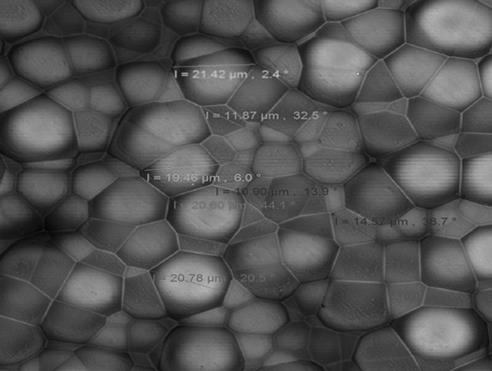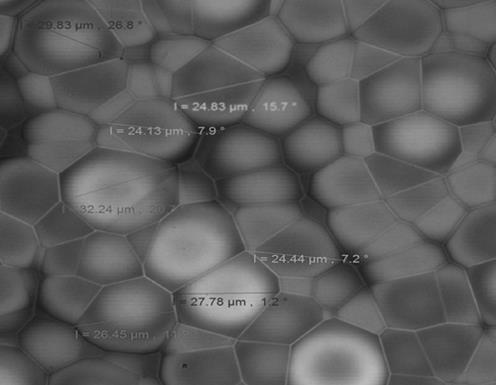Forming process with anti-fingerprint, anti-scratch and wear-resistant glass substrate etching effect
A technology of glass substrate and forming process, which is applied in the field of glass substrate etching effect forming process, which can solve the problems of residual anti-fingerprints on the back cover of glass mobile phones, which is not conducive to the production of equipment manufacturers, and the back cover of glass mobile phones is not resistant to wear, etc. , to achieve stable product quality, easy control, and high production yield
- Summary
- Abstract
- Description
- Claims
- Application Information
AI Technical Summary
Problems solved by technology
Method used
Image
Examples
Embodiment 1
[0026] The present invention is an anti-fingerprint, anti-scratch and wear-resistant glass substrate etching effect molding process, comprising the following steps:
[0027] S1, prepare etching solution according to the following components by weight: 5-10 parts of ammonium bifluoride, 5-10 parts of sodium fluoride, 10-15 parts of p-toluenesulfonic acid, 10-15 parts of methanesulfonic acid, 2-6 parts of oxyethylene ether, 2-4 parts of sodium polyacrylate, 2-10 parts of EDTA, 90-95 parts of water, first grind and mix ammonium bifluoride and sodium fluoride to form a mixture 1; then p-toluenesulfonic acid and Grind and mix methanesulfonic acid evenly to form mixture 2; then stir polyoxyethylene lauryl ether and sodium polyacrylate to form mixture 3; finally raise the temperature of water to 50°C, and while stirring, successively mix mixture 3, EDTA, and mixture 2 and mixture 1 were added to water (after stirring until there was no precipitation, another substance was added), and...
Embodiment 2
[0035] The etching solution is prepared according to the following components in parts by weight: 7 parts of ammonium bifluoride, 5 parts of sodium fluoride, 10 parts of p-toluenesulfonic acid, 13 parts of methanesulfonic acid, 2 parts of polyoxyethylene lauryl ether, and 2 parts of sodium polyacrylate. parts, 10 parts of EDTA, and 90 parts of water; when frosting, the temperature of the etching solution is kept at 28°C, and the temperature difference of the etching solution is controlled within 3%.
[0036] Carry out experiment to glass base material with the etching solution of embodiment two and the molding process of embodiment one, and carry out performance test to the surface of glass base material, obtain following result:
[0037] One is that there is no fingerprint residue on the surface of the glass substrate, the other is that the thickness of the honeycomb-like particle layer measured by the instrument is 45nm, and the hardness is 5H; the third is that the dynamic f...
Embodiment 3
[0039] The etching solution is prepared according to the following components in parts by weight: 5 parts of ammonium bifluoride, 10 parts of sodium fluoride, 15 parts of p-toluenesulfonic acid, 10 parts of methanesulfonic acid, 4 parts of polyoxyethylene lauryl ether, and 4 parts of sodium polyacrylate parts, 7 parts of EDTA, and 93 parts of water; when frosting, the temperature of the etching solution is kept at 32°C, and the temperature difference of the etching solution is controlled within 3%.
[0040] With the etching solution of embodiment three and the molding process of embodiment one, the glass substrate is tested, and the performance test is carried out on the surface of the glass substrate, and the following results are obtained:
[0041] One is that there is no fingerprint residue on the surface of the glass substrate, the other is that the thickness of the honeycomb-like particle layer measured by the instrument is 47nm, and the hardness is 6H; the third is that t...
PUM
| Property | Measurement | Unit |
|---|---|---|
| Thickness | aaaaa | aaaaa |
| Surface energy | aaaaa | aaaaa |
| Drop angle | aaaaa | aaaaa |
Abstract
Description
Claims
Application Information
 Login to View More
Login to View More - R&D
- Intellectual Property
- Life Sciences
- Materials
- Tech Scout
- Unparalleled Data Quality
- Higher Quality Content
- 60% Fewer Hallucinations
Browse by: Latest US Patents, China's latest patents, Technical Efficacy Thesaurus, Application Domain, Technology Topic, Popular Technical Reports.
© 2025 PatSnap. All rights reserved.Legal|Privacy policy|Modern Slavery Act Transparency Statement|Sitemap|About US| Contact US: help@patsnap.com



